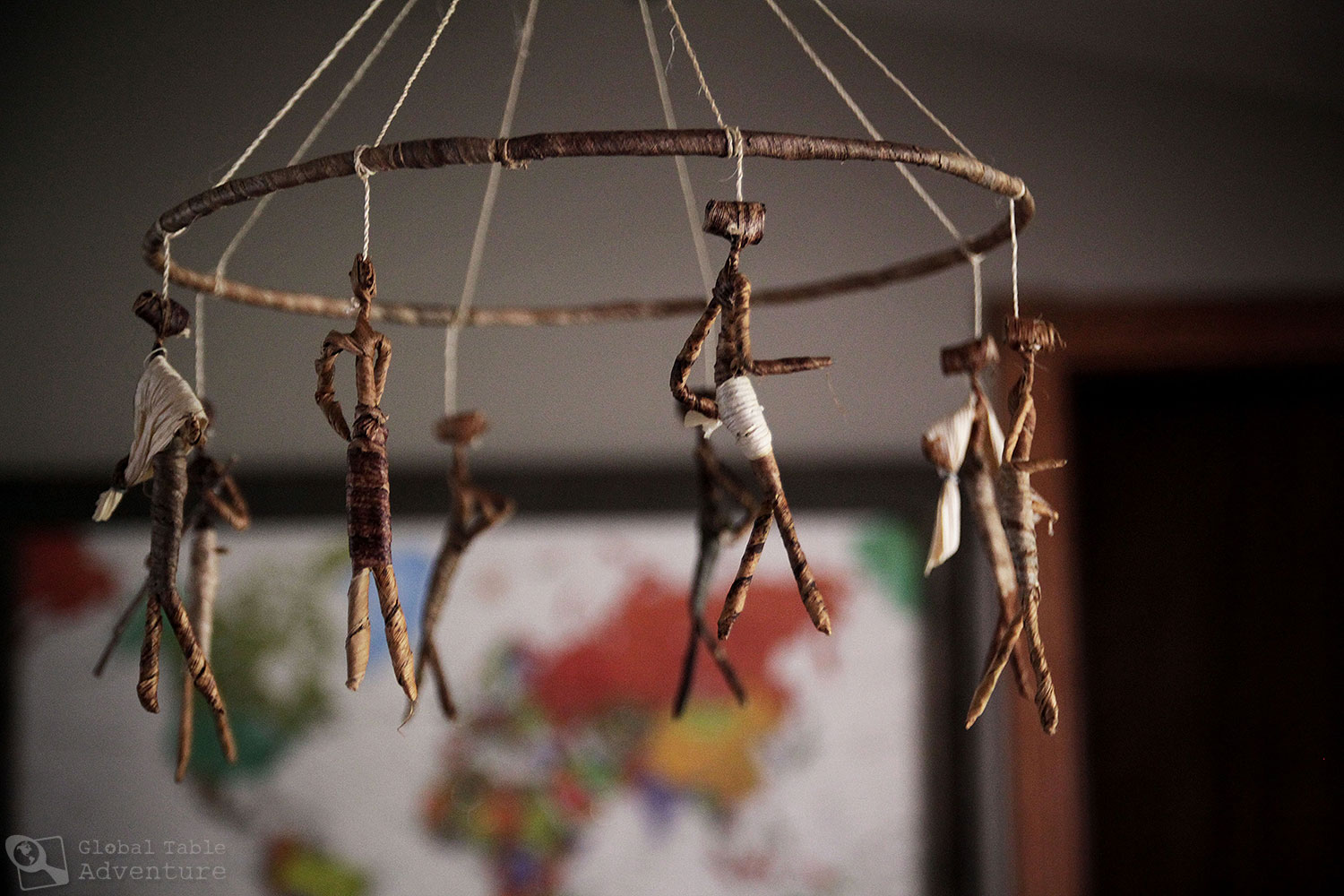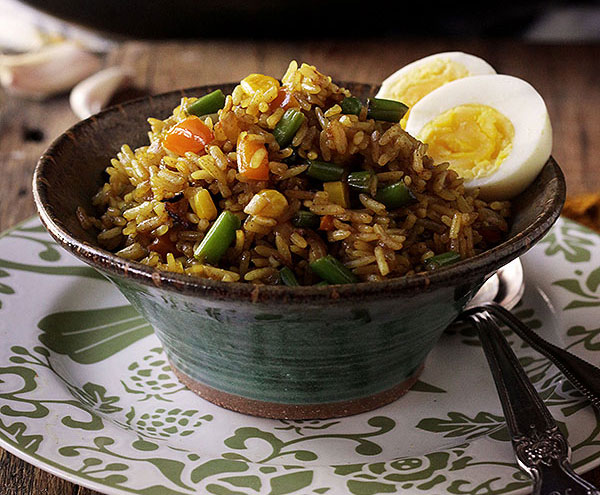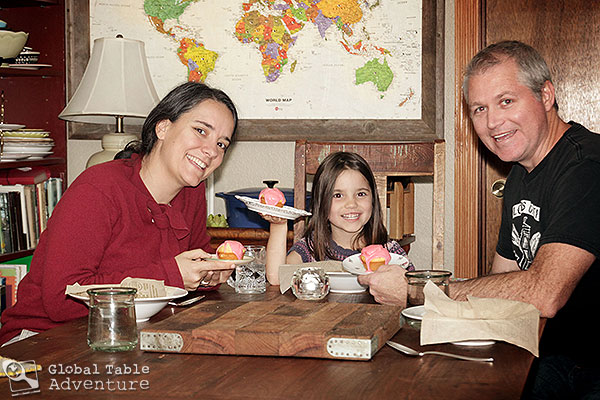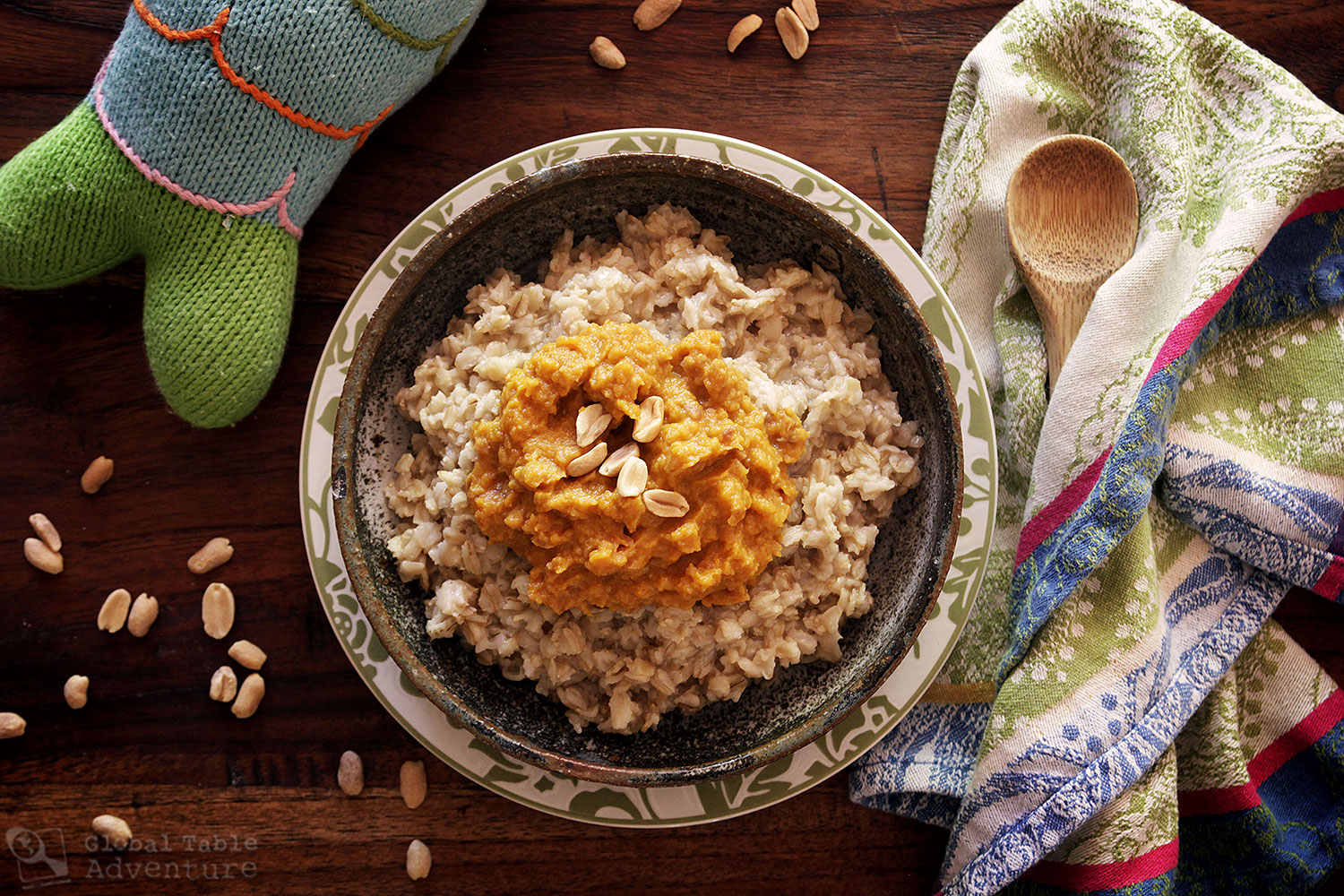
Forget what you know about The Little Mermaid. Zambia’s infamous mermaid, Chitapo, is no dewy-eyed, red-haired princess. To set eyes on this fierce water spirit, paddle along the Zambian/Congolese waterways – along Lake Namulolobwe, down Victoria Falls, into any number of smaller ponds. You might even find her cresting the salty Atlantic. How will you know it’s her? See that shadow caught up in a whirlwind? An elusive figure sunning on a rock, with the body of a woman and the tail of a fish or serpent? That’s Chitapo. Beware: Beautiful Chitapo is not content to observe humans from afar. Pay attention if things seem amiss in your village. Did a woven mat or a few beloved baskets vanish, then reappear a few days later? Is a neighbor’s missing collection of pots and pans now floating on the murky lake? Chitapo pushes this shiny bait in the shallows, luring unsuspecting victims to their untimely death. Tempted to wade into the water to retrieve these prizes? Think you can outwit, or out-muscle this water spirit? Good luck. Even those with unflinching biceps and …
Read More

A spoonful of Tanzania’s Coconut Potato Soup garnished with moons of buttery avocado will transport you to the windswept slopes of Mount Kilimanjaro. Never fear: The howl you’ll hear as you chow down won’t be the wind on your face, or some dangerous beast – but rather the horn of the Wakonyingo, calling for help. Wakonyingo: Fact or fiction? More than a hiker’s haven, Mount Kilimanjaro is a wellspring of legends involving the Wakonyingo pygmies. The stories fall somewhere between history and fairy tale. History reports that the Wakonyingo were an early tribe inhabiting Kilimanjaro, driven out or absorbed by invading tribes. The fairy tales report a far more interesting story – that the Wakonyingo fled beneath the mountain, where they remain today. Legends claim they are still down there, hidden from sight in a network of tunnels and caves, living a life any gnome would love. They keep their cattle with them and even grow banana trees in their earthen lairs. Ladders from their caves are said to reach the heavens. Turns out this underground lifestyle isn’t so far-fetched. The Chagga people (also Chaga), who’ve …
Read More
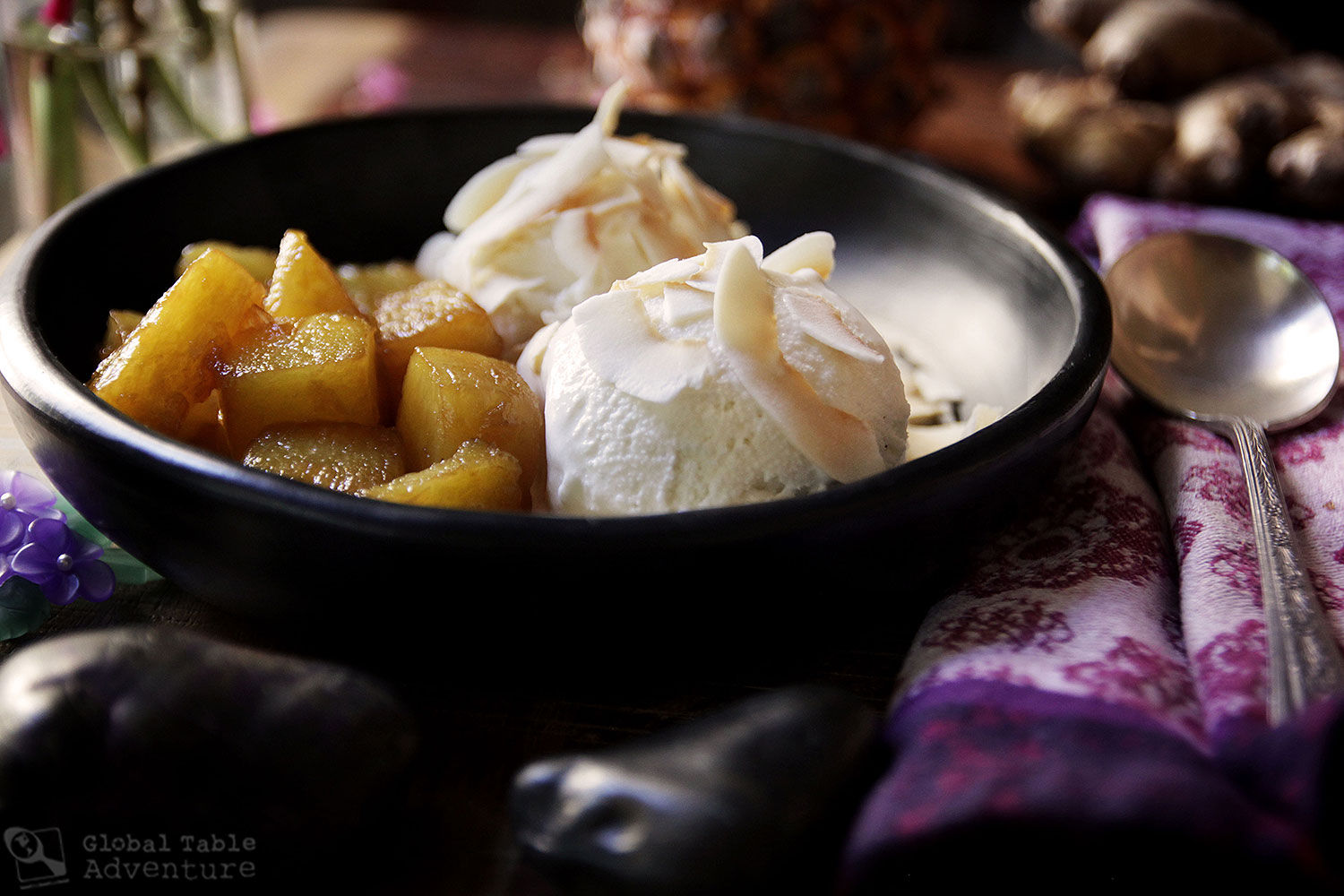
Let’s travel to Sub-Saharan Africa, where the flavors of the tropics make an ordinary ice cream sundae outstanding. Start by harvesting real vanilla beans from Madagascar to make the ice cream. Then head to Nigeria to pluck a heavy, sweet pineapple and a knob of ginger root. Nigeria is the world’s 8th largest producer of pineapple and the 4th largest producer of ginger.* Chunk up the golden fruit, then cook it with brown sugar and a whisper of the freshly grated ginger. Ten minutes on a flame will release the pineapple juices into the brown sugar, making a sticky, caramel-like sauce. Look how tall my little girl is getting… Sometime this fall she stopped using the step stool. I always knew bringing the world into our kitchen was good nourishment, but she grew an inch over the summer. <sigh> When you’re done bemoaning how fast life flies, assemble your ice cream sundae. First: Drop two fat scoops of vanilla ice cream into a shallow bowl. Second: Spoon on the hot pineapple and sauce. Work quickly to sprinkle with lightly toasted …
Read More
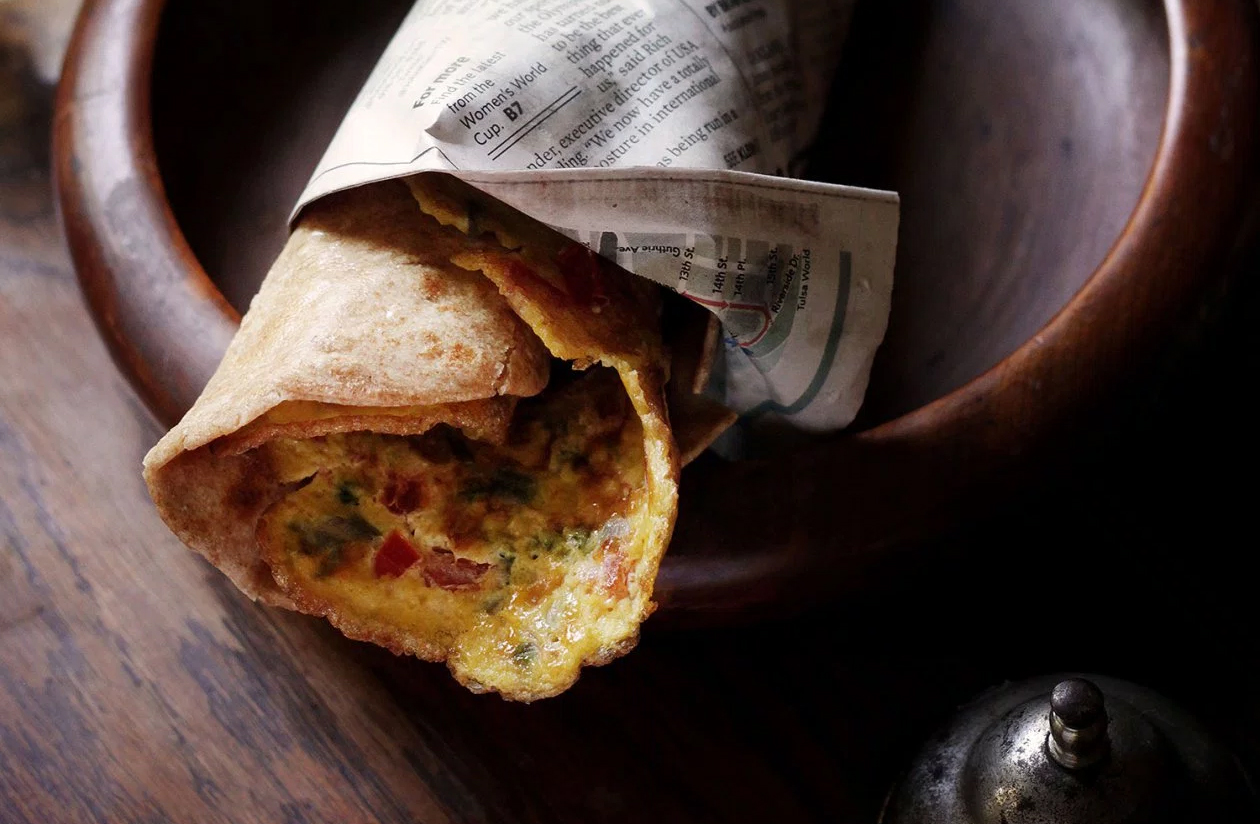
Uganda’s “Rolex” is breakfast luxury that can be purchased on any street corner. Whipped egg is the gold setting. Precious studs of tomato and purple onion glitter across the surface like garnet and amethyst, while fine strands of cabbage sparkle like peridot. The completed jewel is nestled safely in a soft chapati wrap. Ridiculous? Maybe. But shouldn’t every day food be as precious as a “real” Rolex? What is a Ugandan Rolex? Rolex is classic Ugandan street food. The similarity to the luxury watch brand is happenstance: Once upon a time the vendors who made this treat called out “Rolled Eggs” – nothing more. The basic idea is eggs cooked with cabbage, onion, tomato, and sometimes peppers, which is then wrapped in chapati. But, as the words careened off their tongue, “Rolled Eggs” sounded more like “Rolex” to visitors. Gradually the (quite fun) misinterpretation stuck. How do you make a Rolex? To prepare a Rolex in the true Ugandan spirit, a few steps must be followed. First, make your way to Uganda… … and find a welcoming village …
Read More
The stories we share during mealtimes nourish us as much as the food we eat. But sometimes we need a little jump start to get conversation flowing. Kenyans use banana leaves to create artwork that not only evoke ancient folk tales but that inspire the telling of new stories. I found our Kenyan storytelling chandelier at a garden festival called Springfest here in Tulsa. My daughter and I almost breezed right past the booth. The rain had just started coming down in earnest: Ava was dancing in puddles with a friend and I was hunkered beneath my umbrella, feeling grumbly about my wet socks. But then those dancing figures caught my eye. Turns out the chandelier was made by a group of women in Kenya. Proceeds of our sale went back to helping their village. The vendor told me there was a story behind each figure and when I asked her what they were, she coyly responded that it was up to us to tell it. While most might use this sort of art over …
Read More
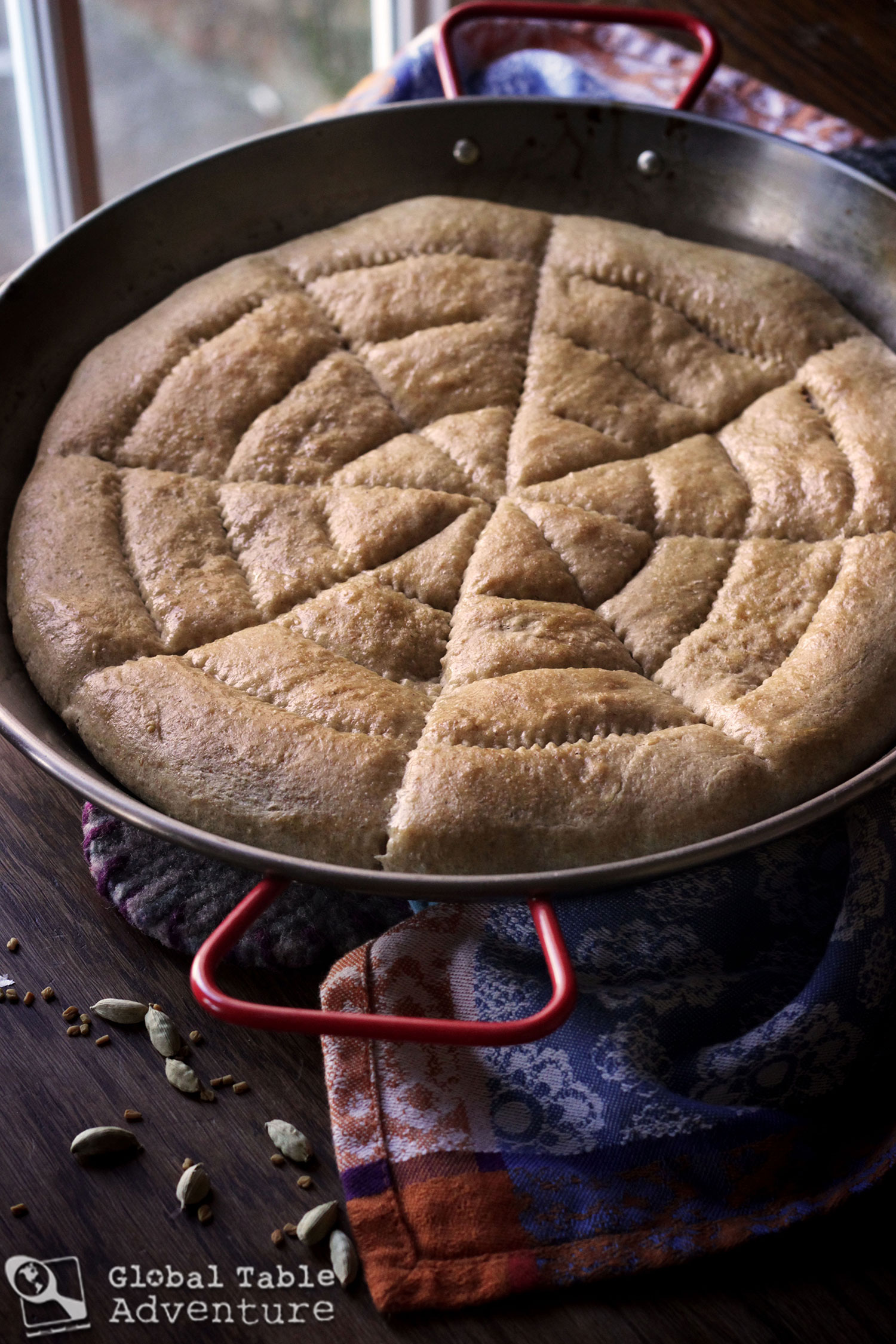
This year Ava and I brought a loaf of Eritrean Hembesha bread to the annual Martin Luther King parade. It’s a random sort of thing to bring to a parade, but I’d just pulled batch #3 out of the oven and couldn’t stand the thought of the bread cooling down without being able to enjoy a still-steaming, soft wedge. There are few things better than a steaming-hot piece of homemade bread. Hembesha is no exception: the east African bread is soft and earthy with whispers of garlic, coriander, cardamom, and fenugreek. The distinct flavor profile is great with hearty stews or even on the side of scrambled eggs (perfect for a savory brunch). That being said, hembesha is traditionally served in the afternoon with tea and a drizzle of honey and/or tesmi (tesemi is spiced ghee made with ginger, garlic, onions, and berbere) While original recipes decorate the flat loaves with nails, I’ve used a ravioli wheel (the idea came from the blog Yesterdish). I learned the hard way – don’t just score the dough – cut through 99-100% of the …
Read More
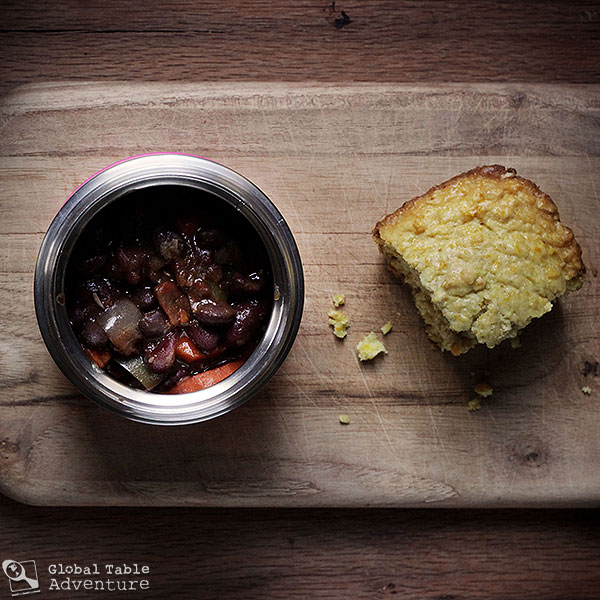
Below freezing weather means one thing: the thermos goes on double duty. This week I filled Ava’s hot pink Hello Kitty thermos with a hearty bean stew bolstered with a swirl of red palm oil – a typical element in West African cooking. On the side – a fat hunk of mealie bread. This is southern Africa’s answer to corn bread (especially popular in South Africa). The fresh corn kernels add sweetness and interest beyond anything Jiffy Mix can offer. Tips and Tricks If you’d like a little spice in your mealie bread try adding some blackened chilie peppers (I like poblanos – here’s a recipe from Zambia). Try adding some sliced plantain to your kidney beans stew or swapping the kidney beans for black eyed peas. Why show you Ava’s lunch? Ava’s Around the World Lunches began when I shared a few of Ava’s globally-inspired lunches on Instagram and Facebook. Turns out a lot of people are looking for lunch ideas – whether for school or work. In this weekly column, I share one of our Around the …
Read More
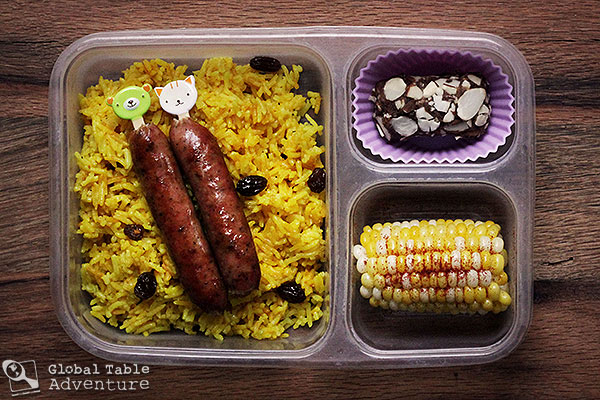
This week Around the World Lunch takes us to South Africa (thanks to your votes on our FB Page). The result is a hearty meal perfect for autumn, packed with nutrition. Watch a clip of Ava introducing this meal (and showing off her South African flag) on Instagram. Get Creative. Who says creativity must be difficult? In a sea of bologna sandwiches, leftovers are a great way to mix things up and add interest to your child’s lunch! For dinner we made a batch of South African Yellow Rice (a.k.a. Geelrys), seasoned with turmeric, a touch of brown sugar, and raisins. While it’s amazing hot, it’s also decent cold the next day. South Africa is famous for her enormous coiled sausages, called Boerewors made up of beef and lamb or pork. These aren’t available here, so I improvised by browning a couple of small breakfast sausages. For cute-factor (and ease for small hands), try putting them on skewers. Balance. Nutrition is packed into the rest of this lunch. First up? Corn. Garnish a boiled ear of corn with a puff of smoky chile powder – a popular treatment …
Read More
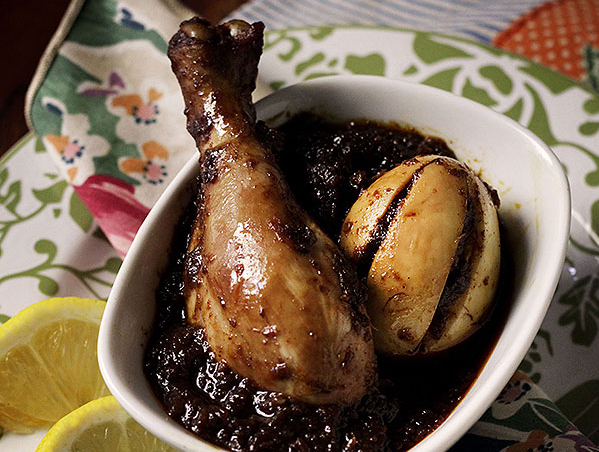
There’s been a movement to make Enkutatash – a.k.a. Ethiopian New Year – as popular as St. Patrick’s Day or Cinco de Mayo. But instead of wearing green or dancing to a mariachi band you’re invited for a much simpler, down to earth sort of celebration. Wear white. Pick yellow daisies. And enjoy traditional Ethiopian food. Waaaay back when “Enkutatash” literally stands for “gift of jewels.” As the story goes, several thousand years ago the Queen of Sheba delivered more than 4.5 tons of gold and as many spices to King Solomon. King Solomon was quite the host as he, too, showered her with gifts: …in return, King Solomon had assembled an array of gifts for her arrival. Great caskets of sticky Nubian millet beer awaited her party. The gifts were staked on mules outside Solomon’s palace, ready for her people to take to their camp and enjoy. Silks and linens from Gaza, Assyria, and Lebanon. Tapestry from Ma-Wara-Mnar. Dresses, sweet fruit from Iraq, Mongolistan winter melons. And basins of water from the spring at Siloe. Following …
Read More

Photos: Moroccan girls by M. Osmenda, Bhutanese girl by C. Michel, & children in Ghana by K. McCormick. The heart of African cooking… I’m so excited about today… because today we’re diving into the heart of African cooking. I’ll be sharing four burger creations inspired by four distinct regions of Africa. It’s not all the same… Next time someone tells you all African food tastes the same (or that they know nothing about African cooking), send them here. I know firsthand how much they’re missing. You see, when I first began cooking the world, I could fill a thimble with what I knew about African cooking. But there is enormous flavor, history, and creativity in Africa. Consider these four African-inspired burgers a teaser. Once your appetite is whetted, go on to the hundreds of recipes for each of the 54 countries in Africa that my family tried when we cooked our way around the world. Let this celebration of Africa’s culinary diversity be a reminder: Africa is not a country. The North African | Tagine Burger Inspired by the sweet and savory tagines of Morocco …
Read More
This Shall Not Die In Yoruba culture, in southwestern Nigeria and Southern Benin, the naming of babies is of the utmost importance – one that the Yoruba people believe will help determine their child’s future – their fate. That’s how a baby might come to be named Kokumo, or “This Shall Not Die.” I’ll be honest, the first time I imagined a baby with the word “die” in their name, I got the chills. But Kokuma is an optimistic, prayerful name. A wish for their child’s well-being – not some morbid statement. Today, in honor of international Name Yourself Day (April 8) I’d like to explore if we can find such power in our names – whether or not where we end up in life can be manifest through clear and purposeful intention repeated like mantra, with something as basic as our very own names. If it is true, then the meaning and sentiment of our names can have a big influence on who we are and what we do with our lives. So we should choose them …
Read More
The marathon is complete. We did it. We ate every country in the world. (Breathe in, breathe out) The first thing Ava said about completing our challenge? “Can we start cooking the world all over again?“ And, later: “When are we going to start another Global Table Adventure, mama?” This child was barely seven months old when we started. Here she is with Afghanistan… (sigh) I can’t look at this photo without tears coming to my eyes. I just… can’t. It symbolizes how much happens in four years. How much changes. I had the strangest sensation as I was taking my last bite of candy cake for Zimbabwe. Every time I blinked my eyes, I’d open them expecting to find my seven month baby nestled in my arms. All over again. That’s probably not what Ava meant when she suggested we start over. But every time I opened my eyes… there Ava was… all grown up, four and a half years old, talking about staying “hwydrated.” I kept blinking. I kept hoping for a moment of …
Read More





